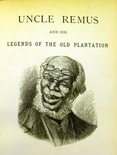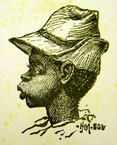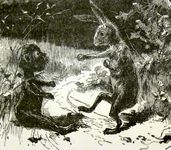Uncle Remus, His Songs & His Sayings: The Folk-lore of the Old Plantation
This is the front inside cover of Uncle Remus, and it depicts the fictional character Uncle Remus, which was based on slaves that writer Joel Chandler Harris had known. The picture depicts African Americans in a negative way with wide mouths and lips, squinty eyes and a congenial nature that belies what really occurred during slavery. However, Uncle Remus remains important as an example of how African Americans were portrayed in the deep south during the period of Reconstruction.
The stories are told by "Uncle" Remus to a precocious young white boy who speaks perfect literary English at a tender age. Remus speaks in a deep south slave dialect that is almost incomprehensible to today's readers. Remus is a kindly old slave who enjoys his enslavement. By the mid-20th century, the dialect, and the old "Uncle" stereotype as well as Harris' racist and patronizing attitudes towards African Americans rendered the book indefensible to most Americans.
One of the stories Uncle Remus regales the boy with is the story of Br'er Rabbit and the Tar Baby. This story concerns a clay doll, which looks eerily like other depictions of African Americans in the book. When Br'er Rabbit punches the tar baby his hand becomes stuck in the clay. This phrase refers to the idea of a problem that gets worse the more one struggles with it.



